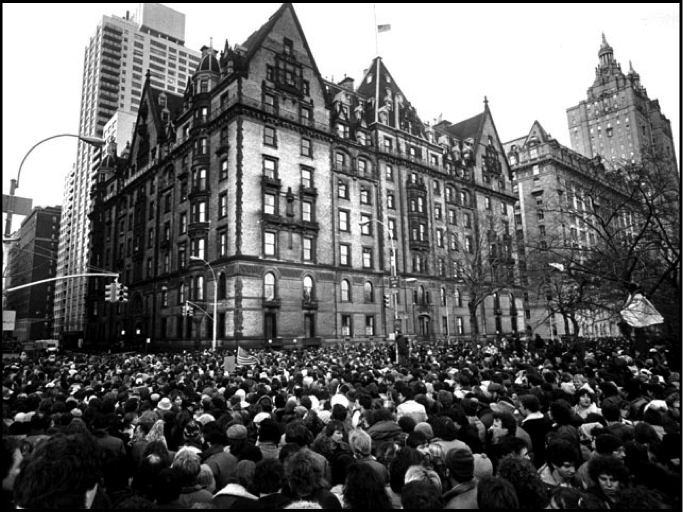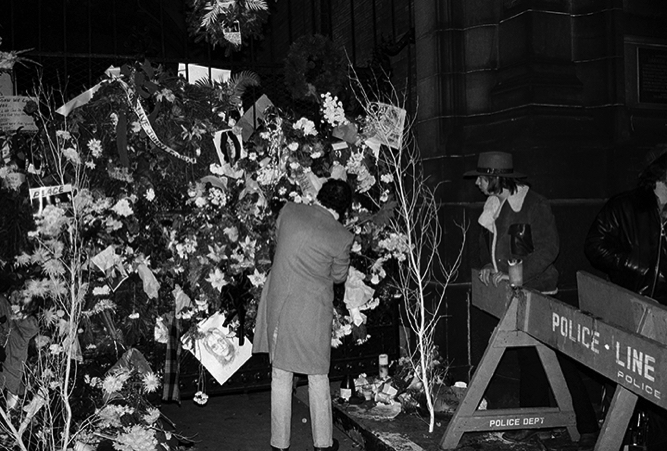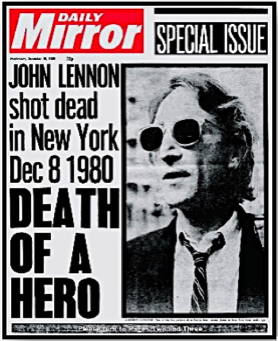Time stopped.

The mourners had turned the Dakota's high wrought-iron gate into an improvised shrine. One by one, they formed a procession through a channel of blue police barricades. Each, in their turn, left a personal note, an album cover, photographs, or flowers. Candles flickered in the driveway, which was also covered with photographs and flowers.

© AP Images
© AP Images
© Getty Images

© AP Images
“Howard Cosell said John Lennon!” my friend repeated. “He said John was shot in front of the Dakota. He was taken to Roosevelt Hospital.” My heart hammered. I hung up—stunned.

“My name is Dr. Stephan Lynn, Director of Emergency Services at Roosevelt Hospital. John Lennon was pronounced dead on arrival at 11:07 P.M. He had lost a great deal of blood from multiple gunshot wounds. A team of trauma surgeons tried to resuscitate him, but his wounds were too extensive—”
Enter Text
On Wednesday afternoon, December 10, I left the Dakota through the building's service entrance, headed to my apartment for a change of clothes and a shower. The walk home through Central Park had cleared my head, so I again walked back to the office. It was just getting dark when I turned the corner onto West Seventy-second Street, and froze in my tracks, startled by what I saw. Hundreds of John's fans had gathered in front of the building. Despite the cold weather, young and old come together to honor him and to offer their tears and their love. “All you need is love,” they sang, “love is all you need . . . love . . . love . . . love . . .”
Minutes later, when I entered the fluorescent glow of the office the chaos had continued unabated. But now there were two more people each with a telephone pressed to their ear. Someone showed me a statement Yoko had prepared for the press. It read in part, “I told Sean what happened and took him to the spot where John lay after he was shot . . . Sean cried later. He also said 'Now Daddy is part of god. I guess when you die you become much more bigger (sic) because you're part of everything.' ” Yoko's statement concluded with a request for a worldwide ten-minute silent vigil to be observed at 2 PM on Sunday, December 14th.
A gasp of disbelief came from the crowd. The lobby erupted into a tumult of sobs and chatter, drowning out the doctor. I overheard a woman behind me say, “That's the end of my generation!”
Trembling and numb, I entered the office of Lennono Music, exchanged looks with the two other staff members already there, and took a seat at a desk. No one spoke.
The sudden ring of a telephone went off like a bomb, shattering the stillness. One by one, each phone line began to ring. Within half an hour, every button flashed an incoming call. Talking on the telephone became a dispensation. The three of us stayed in perpetual motion—it dulled the pain. There were phone calls from every news outlet in the world. People who claimed to be psychics called. Every caller received the same message: “Yoko is not taking any phone calls.” But she talked with Paul and George when they called. Ringo came to the Dakota, so did Elton John. Julian arrived on Tuesday.
Later that day, we began receiving massive bags of mail. The next wave of deliveries was sympathy floral arrangements of every color, shape, and size. Within hours, the office became a veritable jungle. When we came to our senses everything was moved to the Dakota's cavernous basement, eventually filling it wall to wall.
All photos are used in a nonprofit, educational context with the claim of fair use.
This web site is copyright © 2020 by Michael Barbosa Medeiros.
All rights reserved.
After a long day at work, I dozed in front of the television and went to bed early. But the insistent ring of my telephone soon pulled me out of deep sleep.
“Did you hear the news?” the caller asked.
“What are you talking about?” I grumbled, not fully awake.
“They just interrupted Monday Night Football—John was shot!”
“John's at the studio,” I protested. “He's mixing 'Thin Ice' with Yoko.”
About thirty minutes later, I entered the hospital's Emergency room, where a small group was already gathered. Shortly after my arrival, a hospital official entered, and said there would be an announcement about John's condition in the main hospital building. When I entered this building, a large boisterous crowd milled around in the lobby. Television cameras and lights had been set up. Reporters with microphones jostled for position as a man in a long white jacket entered. He gestured with extended arms for everyone to quiet down.
I left the hospital and walked to the Dakota in a trance. When I arrived at the building blue police barricades blocked the entrance. Several hundred people had already gathered. Some held candles or flowers, some wept, still others clutched pictures of John. Some groups chanted Beatles songs, but most stood in stunned silence.
HELTER SKELTER
Después de un largo día de trabajo, dormí frente al televisor y me fui a la cama temprano. Pero el insistente timbre de mi teléfono pronto me sacó de un sueño profundo.
"¿Has oído las noticias?" preguntó la persona que llamó.
"¿De qué estás hablando?" Gruñí, no completamente despierto.
"Acaban de interrumpir el Monday Night Football: !Le dispararon a John!"
"John está en el estudio", protesté. "Está mezclando "Thin Ice" con Yoko".
Aproximadamente treinta minutos después, entré en la sala de emergencias del hospital, donde ya estaba reunido un pequeño grupo. Poco después de mi llegada, entró un funcionario del hospital y dijo que habría un anuncio sobre el estado de John en el edificio principal del hospital. Cuando entré en este edificio, una gran multitud bulliciosa se arremolinaba en el vestíbulo. Se habían instalado cámaras de televisión y luces. Los reporteros con micrófonos se empujaban entre sí por un puesto cuando entró un hombre con una chaqueta blanca larga. Hizo un gesto con los brazos extendidos para que todos se callaran.
Mi nombre es Dr. Stephan Lynn, Director de Servicios de Emergencia del Hospital Roosevelt. John Lennon fue declarado muerto a su llegada a las 11:07 p.m. Había perdido mucha sangre por múltiples heridas de bala. Un equipo de cirujanos de trauma intentó resucitarlo, pero sus heridas eran demasiado extensas.
Un grito de incredulidad vino de la multitud. El vestíbulo estalló en un tumulto de sollozos y charlas, ahogando lo que decía el médico. Escuché a una mujer detrás de mí decir: "!Este es el fin de mi generación!"
Salí del hospital y caminé hacia el Dakota en trance. Cuando llegué al edificio, barricadas policiales azules bloquearon la entrada. Ya se habían reunido varios cientos de personas. Algunos sostenían velas o flores, algunos lloraban, otros llevaban fotografías de John. Algunos grupos cantaron canciones de los Beatles, pero la mayoría permaneció en silencio atónito.
Temblando y entumecido, entré a la oficina de Lennono Music, intercambié miradas con los otros dos miembros del personal que ya estaban allí y me senté en un escritorio. Nadie habló.
El tiempo se detuvo.
El repentino sonido del timbre de un teléfono estalló como una bomba, rompiendo la quietud. Una a una, cada línea telefónica empezó a sonar. En media hora, todos los botones mostraban una llamada entrante. Hablar por teléfono se convirtió en una dispensa. Los tres permanecimos en perpetuo movimiento, eso mitigó el dolor. Hubo llamadas telefónicas de todos los medios de comunicación del mundo. Llamaron personas que decían ser psíquicos. Todas las personas que llamaron recibieron el mismo mensaje: "Yoko no acepta ninguna llamada". Pero ella habló con Paul y George cuando llamaron. Ringo llegó al Dakota, al igual que Elton John. Julian llegó el martes.
Más tarde ese día, comenzamos a recibir enormes bolsas de correo. La siguiente ola de entregas fueron los arreglos florales de condolencias de todos los colores, formas y tamaños. En cuestión de horas, la oficina se convirtió en una auténtica jungla. Cuando recobramos el sentido, todo se trasladó al sótano cavernoso del Dakota, llenándolo finalmente de pared a pared.
El miércoles por la tarde, 10 de diciembre, salí del Dakota por la entrada de servicio del edificio y me dirigí a mi apartamento para cambiarme de ropa y darme una ducha. El camino a casa por Central Park me había aclarado la cabeza, así que volví a la oficina. Estaba oscureciendo cuando doblé la esquina en West 72nd Street, y me quedé paralizado, sobresaltado por lo que vi. Cientos de fanáticos de John se habían reunido frente al edificio. A pesar del clima frío, jóvenes y mayores se unen para honrarlo y ofrecerle sus lágrimas y su amor. “Todo lo que necesitas es amor”, cantaron, “El amor es todo lo que necesitas. . . amor . . . amor . . . amor . . ."
Los dolientes habían convertido la alta puerta de hierro forjado del Dakota en un improvisado santuario. Uno a uno, formaron una procesión a través de un canal de barricadas policiales azules. Cada uno, a su vez, dejó una nota personal, la portada de un álbum, fotografías o flores. Las velas parpadeaban en el camino de entrada, que también estaba cubierto de fotografías y flores.
Minutos más tarde, cuando entré al resplandor fluorescente de la oficina, el caos había continuado sin cesar. Pero ahora había dos personas más, cada una con un teléfono pegado al oído. Alguien me mostró una declaración que Yoko había preparado para la prensa. Decía en parte: “Le conté a Sean lo que pasó y lo llevé al lugar donde yacía John después de que le dispararan. . . Sean lloró más tarde. También dijo 'Ahora papá es parte de Dios. Supongo que cuando mueres te vuelves mucho más grande (sic) porque eres parte de todo'”. La declaración de Yoko concluyó con una solicitud de una vigilia silenciosa de diez minutos en todo el mundo a las 2 de la tarde del domingo 14 de diciembre.
Traducido por Carlos Larriega © 2021
❑
Leer en Español, desplácese abajo